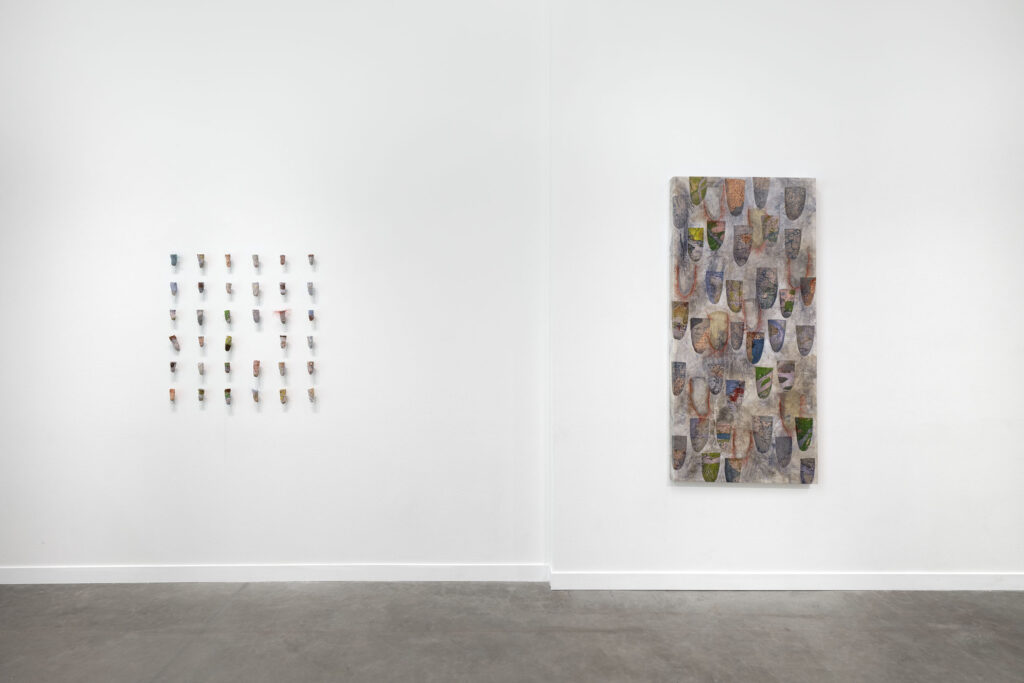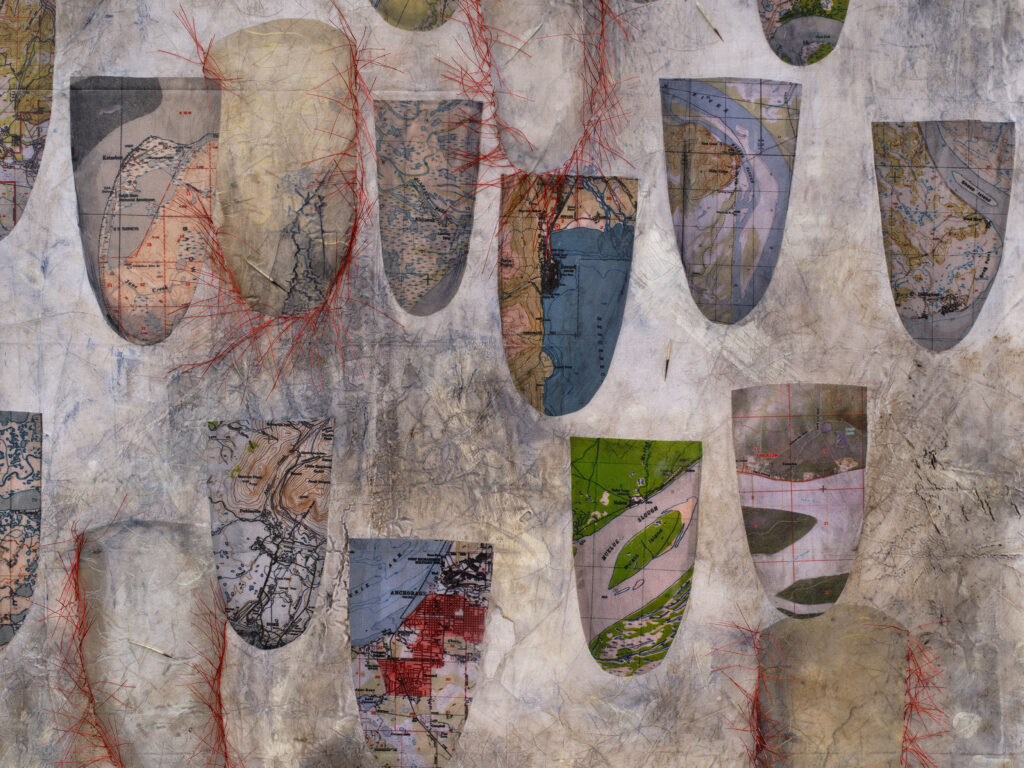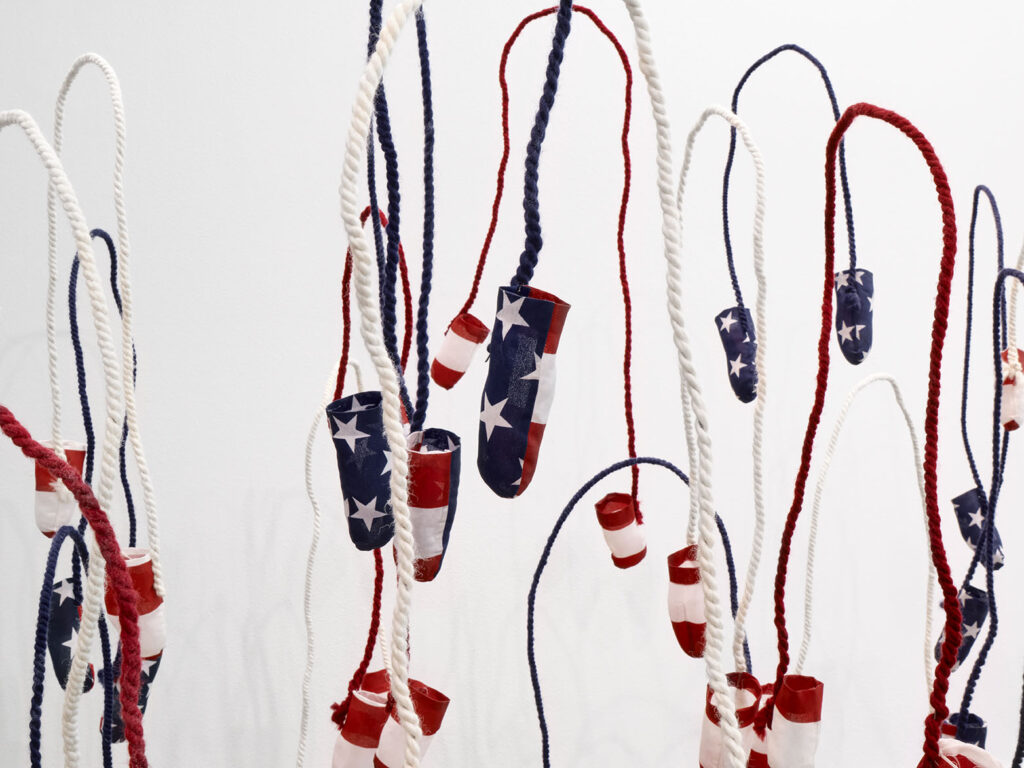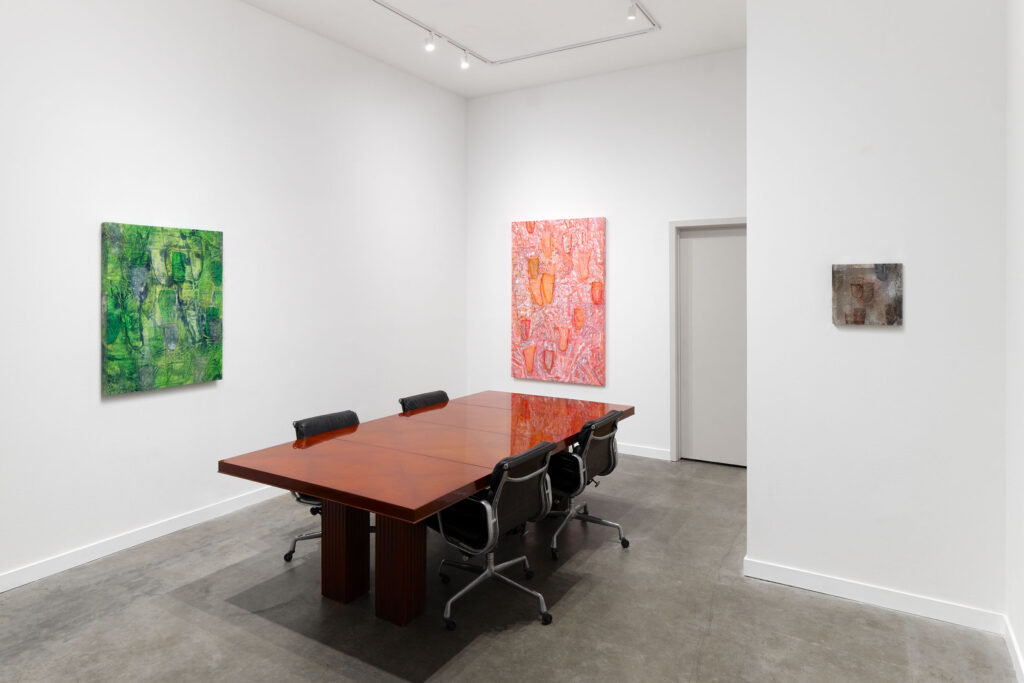Mark
Sonya Kelliher-Combs
September 23–November 4, 2023
STARS presents Mark, the gallery’s first show with Anchorage-based artist Sonya Kelliher-Combs (Iñupiaq/Athabascan). Mark is a two-venue exhibition, co-presented with Tureen in Dallas, featuring bodies of work that merge synthetic and natural materials to center Indigenous collectivities against destructive settler practices in Alaska and beyond.
Since the late 1990s, Kelliher-Combs has depicted her take on the walrus tusk form—customarily worn on parkas—as symbols in her interlocking Secrets series. As paintings or as sculptures, these symbols accrue metaphoric power. Some refer abstractly to the potency of secrecy: as personal protection, as the socially unspoken, or as the historically obscured. Others reveal more specific secrets: the Credible Secrets,on view in both galleries, refer to the 35 recognized abuse claims by Alaska communities against the Catholic Church.
Left open or stitched closed, as sculptural containers the Secrets mediate what is outside and what is kept—or forced—within. Blending beads, U.S. Geological Survey maps, nylon string, hair, and skins and intestines, they’re worked into forms that continually reveal themselves and their textures and hidden content. The two-dimensional Secrets are no less materially rich: Kelliher-Combs creates a kind of synthetic skin from acrylic gel. Applied on muslin, the surface quality appears fleshy, and gestures appear scar-like. Each layer signifies generations, the opacity and transparency of the material giving form to the latent feelings that can’t quite find language or resolution.
Kelliher-Combs works with materials central to subsistence hunting—skins and intestines from walrus, seal, and reindeer, for example. Yet the human-made is quite literally woven in—or, in many works, it is not at all immediately clear what might be land-based or what is synthetic. The red Slips at Tureen could seem reminiscent of a de-fleshed hide or a thin garment. Kelliher-Combs produced these works as a response to accounts of institutional and interpersonal abuse she’s heard throughout Alaska and reaction to the pain, anger, and destruction that these traumas visit and revisit upon individuals and communities.
Kelliher-Combs’s work frequently draws on gendered cultural knowledge and intergenerational practices, and she invites members of her family and community into her process. Her Idiot Strings began in 2005 as a project engaging friends and family to hew abstract, cocoon-like pouches from walrus stomach, sheep and reindeer hide, found bed sheets, maps, flags, and clothes. The series’ title refers to tethers used to hang mittens, and the attached sculptural pockets are roughly hand-sized, suggesting an absent body. Idiot Strings began in part as a memorial to three of the artist’s uncles who died by suicide, a cause of death which disproportionately affects Indigenous North Americans. On view in Red, White, and Blue at STARS, the 2023 Idiot Strings appropriates the U.S. flag to acknowledge the history of a nation built on enduring foundations of violence and marginalization towards many communities.
At Tureen, Kelliher-Combs displays her New Artifacts series, initiated during the 2021 lockdown when she was collecting various objects from nearby beaches and dialoguing with the artist Maureen Gruben, whom she was supposed to be working with during an in-person residency. The title references the museological and anthropological practices that appropriate Indigenous culture—and Indigenous bodies—as artifacts from a “dying people.” As new “discoveries” of a sort, they arrive from the blurry realm between the land-based and human-made. These found objects—wood or rope alike—have been reshaped by natural forces. In Kelliher-Combs hands they’re transformed again, with her own hand, automotive paint, and symbols and marks. Existing in a speculative place that isn’t quite nature or culture, these artifacts are recovered from a past that has yet to arrive.
Marking time, marking place; leaving a scar—on an individual or a population; creating the dividing lines of nations and history; asserting presence: the mark, the central element from which it’s argued much art emerges, is hardly neutral territory. By juxtaposing land-based and synthetic materials, abstract and narrative forms, and individual and collective creation, Kelliher-Combs exposes and challenges Western consumptive and control-driven ideologies. Mark continues Kelliher-Combs’s commitment to not only commenting on settler society’s impact on Indigenous peoples and their Native lands, but opens possibilities for community, advocacy, and action.
Sonya Kelliher-Combs (b. 1969, Alaska) is an Iñupiaq and Athabascan multidisciplinary artist based in Anchorage, Alaska. She has a BFA from the University of Alaska Fairbanks and an MFA from Arizona State University. Her work is currently featured in The Visceral Trilogy exhibitions at Alaska State Museum and the traveling exhibition Arctic/Amazon: Networks of Global Indigeneity currently on view at Art Gallery of Nova Scotia, Halifax and previously The Power Plant, Toronto. A forthcoming monograph of her work will be published by Hirmer Verlag in spring 2024, edited by Julie Decker, Ph.D. Her solo exhibitions include Yukon Arts Center, Canada (2019); Minus Space, Brooklyn (2019); Carrie McLain Museum, Nome, AK (2016, 1994, 1990); International Gallery of Contemporary Art, Anchorage, AK (2015); Dartmouth College, Hanover, NH (2014); UC Davis, CA (2012); Museum of Contemporary Native Art, Santa Fe, NM (2011); National Museum of Indian Art, New York, NY (2010); and Anchorage Museum, Anchorage, AK (2005). She’s been featured in the important group exhibitions Heart of Our People, Minneapolis Institute of Art, MN (2019); Art for a New Understanding, Crystal Bridges, AK (2018); SITELINES: Much Wider Than a Line, SITE Santa Fe, NM (2016); Changing Hands 2: Art without Reservation, Museum of Arts and Design, New York (2005). She is a recipient of the United States Arts Fellowship, Joan Mitchell Fellowship, Eiteljorg Fellowship for Native American Fine Art, Rasmuson Fellowship, Anchorage Mayor’s Arts Award and Alaska Governor’s Individual Artist Award. Her work is included in the collections of Anchorage Museum, Alaska State Museum, Denver Art Museum, Eiteljorg Museum, Forge Project, IAIA Museum of Contemporary Native Art, National Museum of the American Indian, University of Alaska Museum of the North, and Whitney Museum of American Art.























